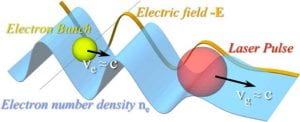Using a high density gas jet enables relativistic acceleration of electrons in plasma wakefields with lower laser powers, leading the way to truly portable laser accelerators.
Accelerators are one of the basic tools of modern science, accelerating particles near the speed of light to probe fundamental nuclear and particle physics, or to drive medical imaging and industrial processes. The basic design for conventional electron accelerators is the radio frequency linear accelerator (RF linac). Since damage thresholds limit RF-structures to accelerating fields on the order of 100 MV/m, these systems are large, extending well beyond a kilometer for high energy experiments. Laser wakefield acceleration of electrons in plasma provides a way of shrinking the size of accelerators because lasers are capable of producing enormous fields, and there is no damage threshold in a plasma. Recent work in our lab on wakefield acceleration in dense plasma jets opens up the opportunity to shrink accelerators even further, using lower energy laser pulses.
Wakefield acceleration uses ultrashort laser pulses to excite large plasma waves, which in turn create large longitudinal electric fields capable of accelerating electrons to relativistic speeds in the laser’s “wake,” as shown in the figure below. While wakefield acceleration has succeeded in making high quality, high energy electron beams, multi-terawatt lasers have generally been required, and the number of accelerated electrons is relatively low. Our lab has developed a novel, cryogenically cooled, high density gas jet which enables laser wakefield acceleration of electrons with much lower laser powers, as related in our paper in Physical Review Letters.

Top, Schematic of laser wakefield acceleration. Image from [1]. Bottom, experimental concept. Image credit: George Hine.
These results open the way to truly widespread laser-driven accelerators, since commercial high repetition rate femtosecond lasers with millijoule (subterawatt) pulses are common in scientific laboratories, unlike large multiterawatt systems. An article from CMNS highlighted our work and explores some of the possible uses, while other recent papers extended our work to a kHz system and mid-IR laser drivers, and studied radiation emitted during the injection process.
References:
[1] F. Albert et al., Plasma Phys. Control. Fusion 56, 084015 (2014).

